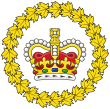Liberalism in Canada
Liberalism has been a major trend in Canadian politics since the late 18th century. Canada has the same features of other liberal democracies in the Western democratic political tradition. This article gives an overview of liberalism in Canada. It includes a brief history of liberal parties with substantial representation in parliament. Canadian liberalism is different from the American use of the term, as it contains ideas such as support for economic liberalism.
 |
|---|
| This article is part of a series on the politics and government of Canada |
| Government (structure) |
|
|
|
|
|
|
Related topics
|
|
|
Liberalism in Canadian history
Historically, Canada has had two liberal phases. Prior to the 1960s, Canadian politics were classically liberal, i.e., there was a focus on individual liberty, representative government, and free markets. This brand of liberalism can be traced to the arrival in Canada of the United Empire Loyalists and the enactment of the Constitutional Act of 1791. The Constitutional Act established representative government through the elected assemblies of Upper and Lower Canada. While the Loyalists were faithful to British institutions and opposed to American republicanism, they were committed to North American ideals of individual liberty and representative government. This brand of liberalism was prominent through the Liberal government of Wilfrid Laurier, which advocated such policies as free trade with the United States, and beyond.
The second liberalism began, roughly, in the 1960s with the election of Lester B. Pearson as leader of the Liberal Party of Canada and can be traced through the politics of Pierre Trudeau, Jean Chrétien, and Paul Martin. This liberalism is what is properly called in a global context social liberalism, or what contemporary North American use of the word signifies as liberalism: liberal democracy, social justice, social progressivism, Third Way, multiculturalism, diplomacy in foreign policy, and a regulated free market economy (during the Trudeau era the Liberals arguably supported a mixed economy).
There is argued to be a third phase of liberalism emerging that is centred on a more sustainable form of politics. The argument is that action is needed to ensure that the environment, economy, and social elements of society will function not only in the short term, but long term as well. If action is not taken on all of these pressing issues then it can cause a direct threat to our freedoms. This emerging new liberalism is centred on an ideal of 'timeless freedom' which seeks to preserve the freedom of future generations through proactive action today. This would extend both positive and negative rights and responsibilities to future generations.
Liberal parties
Liberal parties developed in both the French and English speaking parts of Canada, and led to the formation of the Liberal Party of Canada. Liberal parties exist on a provincial level, but while they mostly share similar ideologies, not all provincial parties are officially affiliated with the federal party.
In Canada, a "capital-L" liberal refers to the policies and ideas of the Liberal Party of Canada/Parti Libéral du Canada (member LI), the most frequent governing party of Canada for the last century and one of the largest liberal parties around the world. The Quebec Liberal Party (Parti libéral du Québec) combines liberalism with more conservative ideas. Only federal parties are included in the following timeline. For inclusion in this scheme, it isn't necessary for parties to have explicitly labelled themselves as a liberal party.
Timeline
Canadian Party / Patriot Party / Red Party
- 1806: Liberals in the Francophone part of Canada formed the Canadian Party (Parti Canadien)
- 1826: The party is renamed Patriot Party (Parti Patriote) and is led by Louis-Joseph Papineau
- 1848: The party is further reorganised into the Red Party (Parti rouge)
- 1867: The PR merged into the present-day Liberal Party of Canada
Reform Party
- 1841: The Upper Canada Reform Party is formed
- 1855: Radical members formed the Clear Grits.
- 1867: The Reform Party merged into Liberal Party of Canada
Clear Grits / Liberal Party of Canada
- 1855: Radical members of the Reform Party formed the Clear Grits
- 1867: The Clear Grits merged with the Reform Party, the Red Party and provincial liberal parties into the present-day Liberal Party of Canada
Current status
In addition to the federal party, each province and the Yukon territory has its own Liberal Party; however, those in British Columbia, Alberta, Saskatchewan, Manitoba, Ontario and Quebec are no longer affiliated with the federal party. The British Columbia Liberal Party is notably centre-right and often described as a "free enterprise coalition", with supporters from both the federal Liberal and Conservative parties.[1] Under their system of consensus government, political parties are not recognized in the territories of Nunavut and Northwest Territories.
Liberal leaders
Parti Patriote
Clear Grits
Parti Rouge
Liberal Party of Canada
- Alexander Mackenzie
- Edward Blake
- Wilfrid Laurier
- Daniel Duncan McKenzie
- William Lyon Mackenzie King
- Louis St. Laurent
- Lester Bowles Pearson
- Pierre Elliott Trudeau
- John Turner
- Jean Chrétien
- Paul Martin
- Bill Graham
- Stéphane Dion
- Michael Ignatieff
- Bob Rae
- Justin Trudeau
Prominent Liberals
Federal
Provincial
Governor General of Canada
Liberal thinkers
- Mario Bunge - Argentinian-Canadian professor of philosophy.
- Matthew Kalkman - author of New Liberalism.
- Michael Ignatieff - political philosopher and former leader of the federal Liberal Party.
- Will Kymlicka - Canadian liberal thinker included in Contributions to liberal theory
- Jan Narveson - Canadian political philosopher and defender of libertarianism, or classical liberalism, currently Emeritus Professor of Philosophy, University of Waterloo
References
- McElroy, Justin (May 6, 2017). "Why the B.C. Liberals are sometimes liberal and sometimes not". CBC News. Retrieved August 13, 2019.
